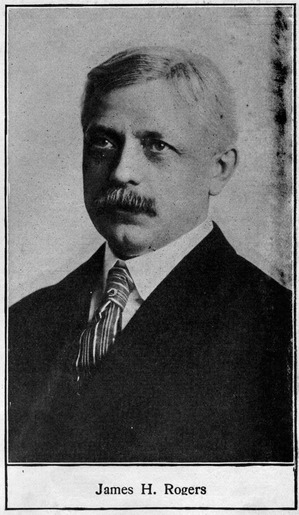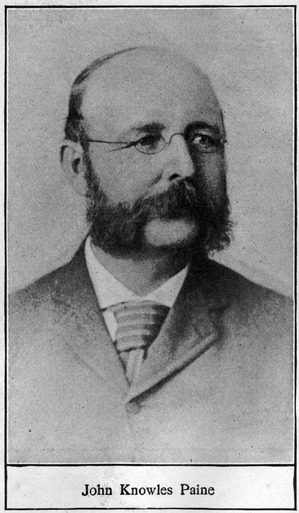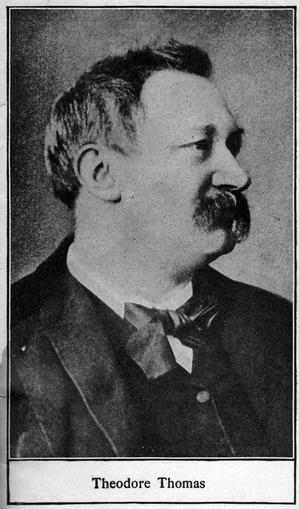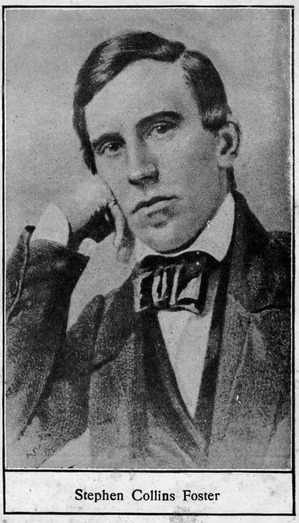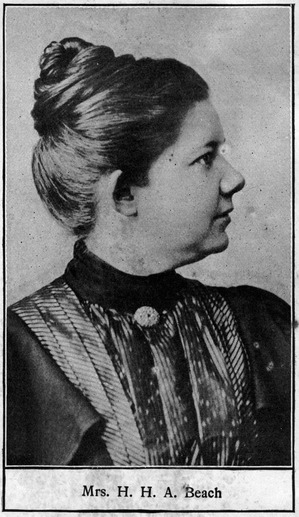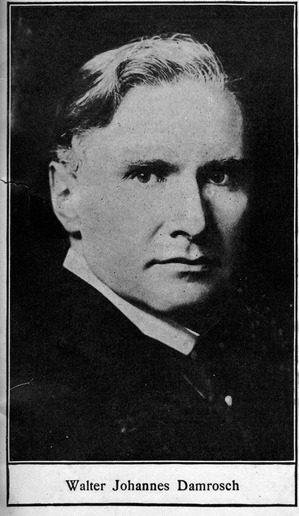Mr. Rogers was born at Fair Haven, Conn., February, 1857. After studying for awhile in his own country, in 1875 he went abroad and continued his studies in Berlin. He was a pupil of Loeschhorn and Ehrlich for pianoforte, Rohde for theory and organ, and Haupt for organ. In Paris he studied pianoforte with Fissot, organ with Guilmant, and composition with Widor. In 1880 he returned to the United States, having had five years study abroad. During the following year Mr. Rogers became organist of the Scovill Avenue Temple and Unity Church, Cleveland, Ohio, and has remained in that city ever since. Naturally his services are in very great demand, both as a teacher and as a concert organist, but, nevertheless, Mr. Rogers has managed to keep a certain amount of time available for composition. He has published over a hundred compositions. His works include a Lenten cantata, The Man of Nazareth; an Easter cantata, The New Life, and many other compositions both sacred and secular. Mr. Rogers is one of the few American composers who is fully qualified to write in the modern French style. His song entitled “At Parting” is one of the greatest songs composed by an American writer. He has also written many technical works, and some octave studies, which he has composed, now in course of publication, will be found very useful by piano students.
Professor Paine was born January 9, 1839, and died at Portland, Me., April 15, 1906. He received his first musical instruction from Herman Kotzschmar, of Portland. In 1858 he went to the Hochschule für Musik in Berlin, studying under Haupt, Wieprecht and Teschner. For a time he gave organ concerts in various German cities, but in 1861 he returned to the United States. Back in his own country he soon established a fine reputation as an organist and teacher. John Knowles Paine was appointed Instructor of Music at Harvard University in 1862 and was eventually appointed Assistant Professor of Music in 1873, and full Professor in 1875. He was the first incumbent of a Chair of Music in any American University. He also served Harvard University as College Organist. He received the honorary degree of Master of Arts from Harvard in 1869, and that of Doctor of Music from Yale in 1890. Paine endeavored all his life to raise the standard of music throughout the country. Among the more successful of his pupils may be mentioned Foote, Converse, Coerne, Clayton Johns, Surette, Aldrich, Finck and Apthorp. As a composer he was not a prolific writer, but he wrote in the larger forms in a way which showed him to be a careful and scholarly writer. His chief work, perhaps, was the oratorio St. Peter.
Mr. Thomas was born at Esens, East Friesland, October 11, 1835, and died in Chicago, January 4, 1905. He received very irregular musical instruction, but was taught to play the violin by his father. In 1845 the family came to New York, and Thomas soon became associated with various musical matters in the city. Six years later he went on tour as a concert soloist, eventually appearing with Lind, Grisi, Sontag, Mario, etc. His association with Mason, and the formation of the Mason- Thomas soirees were of great benefit to the musical development of New York, and at the same time Thomas organized orchestral concerts which were highly successful. He also conducted the Cincinnati Festivals with marked success. In 1878 he became president of the Cincinnati College of Music, but two years later he became conductor of the Philharmonic Orchestra in New York. In 1888 he was induced to leave New York for Chicago, where he was appointed head of the conservatory in that city. Theodore Thomas became conductor of the Chicago Symphony Orchestra, and carried out such excellent work that the orchestra has remained a lasting memorial of his genius. The work he did for music in America was almost of incalculable benefit to the country, and his name will always be associated with those other pioneers of music, such as Lowell Mason, Dr. William Mason, Professor Paine and many others who have done so much toward musical development in the new world.
Foster was born near Pittsburg, Pa., July 4, 1826, and died in New York, January 13, 1864. He was of Irish descent, and not of a very studious disposition, yet he managed to teach himself to speak both French and German fairly well, and also learnt how to paint, besides acquiring a taste for the music of Mozart, Beethoven and Weber in his youth. He played the flageolet when he was seven years old, and apparently this instrument played an important part in his boyhood days, for his first composition was a waltz for four flutes. His first published song was Open Thy Lattice, Love, and it appeared in 1842. He wrote about 175 songs in all, including My Old Kentucky Home, Old Dog Tray, Massa’s in de Cold Ground, Gentle Annie, Willie, We Have Missed You, Old Black Joe, and Ellen Bayne. This last song is said to have supplied the melody John Brown’s Body. Probably the most familiar of all his songs is Suwanee River, which was originally purchased by Christy and published under his name with Foster’s consent, though in subsequent editions Foster was given full credit. It has been said by some that Foster “adapted” old folk-songs of African-American origin, but this is probably not the case. More likely he used the negro dialect because his association with the “negro minstrels” of the period enabled him to find a ready sale for songs of this kind.
Mrs. Beach (Amy Marcy Cheney) was born at Henniker, N. H., September 5, 1847 (correction), and, like most musicians of distinction, showed her musical proclivities at an early age. She studied first with her mother, and later with Ernst Perabo and Carl Baermann. She took harmony lessons with Junius Hill for a time, but owes most of her knowledge of musical theory to her own endeavors. Mrs. Beach made her first professional appearance as a pianist at Boston, 1883. She gave several recitals after this, and also appeared with the Boston Symphony and the Thomas Orchestras. Her marriage in 1885 closed her professional career so far as concert work was concerned, though she has occasionally appeared in public since. She had done very little in the way of composition up to the time of her marriage only two of her songs having appeared. Now, however, Mrs. Beach is probably better known to the general public as a composer than as a concert-pianist. Her numerous works include a Gaelic symphony, a concerto for pianoforte and orchestra, a mass in A flat, The Minstrel and the King, for male voices and orchestra, and a Festival Jubilate for mixed voices and chorus, composed for the Chicago Exposition, 1893. Besides these works Mrs. Beach has written several songs, most of which, such as The Year’s at the Spring, are as popular as they deserve to be, which is saying a great deal.
Mr. Damrosch was born at Breslau, Prussia, January 30, 1862, and commenced his studies early in life under the direction of his father and Rischbieter and Draeseke at Dresden. He also studied in New York, after his father brought him to that city in 1871. His teachers in pianoforte were von Inten, Boekelman and Max Pinner. When Dr. Leopold Damrosch began his season of German opera at the Metropolitan in 1884, Walter Damrosch was engaged as assistant conductor, a post in which he continued after his father’s death under Anton Seidl. He succeeded his father as conductor of the Oratorio and Symphony Societies. The Damrosch Opera Company was organized in 1898, with Walter Damrosch as conductor. Many performances were given in New York and other cities of the United States. During the year of 1899 he gave up his work as conductor in order to devote some time to composition, but took it up again later when Maurice Grau was director of the Metropolitan Opera House, where he remained during the seasons 1901-2. He has also occupied the position of director of the New York Philharmonic Society. In spite of his active career, Mr. Damrosch has found time for the composition of works on a large scale. He has written two operas, The Scarlet Letter and Cyrano. In other forms his works include the Manila Te Deum, a violin sonata, and several songs.
HOW TO PRESERVE THESE PORTRAIT-BIOGRAPHIES
Cut out the pictures, following outline on the reverse of this page. Paste them on margin in a scrap-book, or on the fly-sheet of a piece of music by the composer represented, or use on bulletin board for class, club, or school work. A similar collection could only be obtained by purchasing several expensive books of reference and separate portraits. This is the fifth set of picture-biographies in the new series, which commenced in January, and included portraits and life-stories of Hofmann, Anton Rubinstein, von Fielitz, Sullivan, Liza Lehmann, Vieuxtemps, Franck, Wagner, Siegfried Wagner, Dancia, Gadski, Johann Strauss, Paganini, Bach, Paderewski, Foote, Bloomfield-Zeisler, Max Reger, Sauer, Mendelssohn, Balte, Smetana, Marchesi, Hans Sitt, Corey, Mahler, Thalberg, Herbert, Holmes, Dreyschock, Joseffy, Chopin, Spiering, Caruso, Jenny Lind, Offenbach, Rheinberger, Brahms, Lachner, Damrosch, Destinn and Burmester. The series published last year is now obtainable in book-form.


